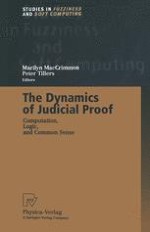2002 | OriginalPaper | Buchkapitel
On the Proof Dynamics of Inference to the Best Explanation
verfasst von : John R. Josephson
Erschienen in: The Dynamics of Judicial Proof
Verlag: Physica-Verlag HD
Enthalten in: Professional Book Archive
Aktivieren Sie unsere intelligente Suche, um passende Fachinhalte oder Patente zu finden.
Wählen Sie Textabschnitte aus um mit Künstlicher Intelligenz passenden Patente zu finden. powered by
Markieren Sie Textabschnitte, um KI-gestützt weitere passende Inhalte zu finden. powered by
“Inference to the best explanation” — here called “abduction” — is a distinctive and recognizable pattern of evidential reasoning. It is ubiquitous at or near the surface of typical arguments offered in judicial and scientific contexts, and in ordinary life. It is part of “commonsense logic.” An abductive argument is open to attack in characteristic ways, and may be defended in characteristic ways by supporting arguments. Abductive arguments are fallible, but there are only a small number of ways in which they can go wrong. This analysis provides a framework for justification, criticism, and dialogue concerning the evaluation of evidence. It should be helpful in the law of evidence and in the training of investigators.It is useful to distinguish among the primary meanings of "abduction." It may refer to a static pattern of argumentation or justification, or the dynamic inferential processes whereby explanatory hypotheses are generated and evaluated, or the processes of constructing arguments, including abductive arguments. It is also useful to recognize that best explanations are almost always composite hypotheses or "theories" comprised of many parts.It is desirable to adopt reasoning strategies that produce conclusions that can in principle be justified. Even better are reasoning strategies in which the confidence in a conclusion arrives bearing a structure of argumentation that can be critically examined, and in which little or no additional work is required to extract, organize, or economize arguments. Reasoning strategies for composing, criticizing, and revising hypotheses, and for justifying conclusions, can be investigated scientifically by implementing such strategies in software and testing their performance.This essay describes a specific reasoning strategy (simplified and idealized from natural reasoning) in which each part of a conclusion formed by using the strategy has a structure of justifications that is strong, but fallible. This strategy has been implemented and performs well in testing. Some possible lessons are drawn for human theory formation, judicial argumentation, and the conduct of investigations. Finally, a definition is suggested for the evidentiary standard "beyond a reasonable doubt."
